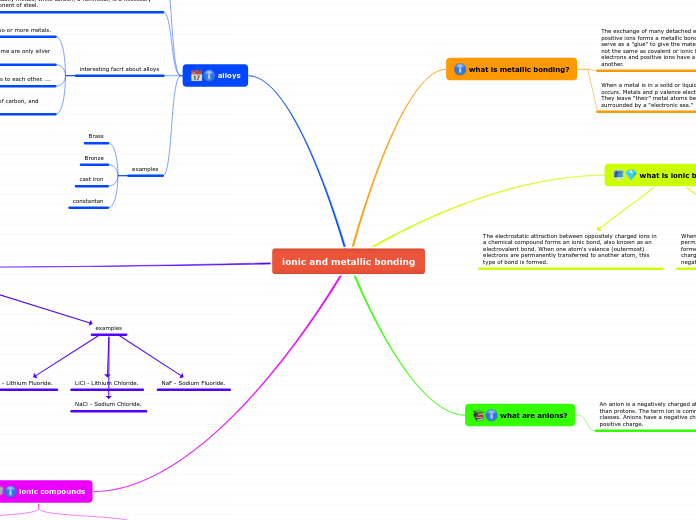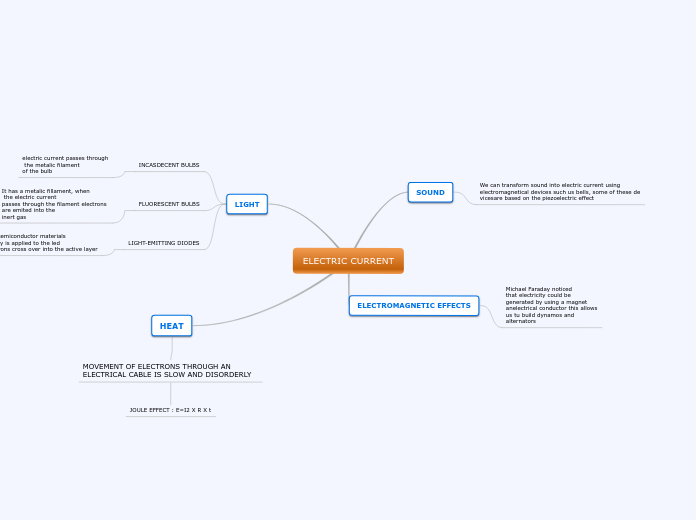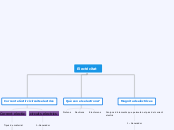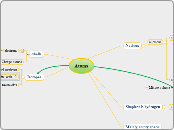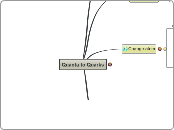ionic and metallic bonding
Type in the name of your subject.
ionic compounds
Add detailed notes about each lecture, so that when the time comes to prepare for exams, you will have an easier and quicker overview.
The formation of positive and negative ions results in the formation of ionic compounds. For each ion, electrons are moved from one atom to another to form rare gas electron structures. The atom that forms a positive ion loses electrons to the atom that forms a negative ion, which absorbs electrons.
Ionic compounds are just that: they're made up of ions. These ions are electron-gaining or electron-losing atoms with a net positive or negative charge. Metals lose electrons and become cations when they have a net positive charge. Non-metals prefer to gain electrons, resulting in anions with a net negative charge.
ionic bonds
Add here all the details about your projects.
NaCl - Sodium Chloride.
NaF - Sodium Fluoride.
LiCl - Lithium Chloride.
LiF - Lithium Fluoride.
There are two ionic bonds. The full movement of electrons from one atom to another forms an ionic bond. A cation is a positively charged ion formed when an atom loses one or more electrons. An anion is a negatively charged ion formed when an atom gains one or more electrons.
The electrostatic attraction between oppositely charged ions in a chemical compound forms an ionic bond, also known as an electrovalent bond. When the valence (outermost) electrons of one atom are permanently transferred to another atom, a bond is formed.
alloys
Schedule your course ahead. Knowing all the information will make everything easier.
constantan
cast iron
Add class name.
Bronze
Brass
interesting facrt about alloys
Stainless steel is an alloy of iron, low levels of carbon, and chromium
Solder is an alloy that is used to bond metals to each other. ...
Many alloys with the word “silver” in their name are only silver in color. ...
An alloy is a blend of two or more metals.
As a compound or a solution, an alloy is a metallic material made up of two or more elements. The constituents of alloys are usually metals, while carbon, a nonmetal, is a necessary component of steel.
Mixing two or more elements, at least one of which is a metal, produces alloys. This metal is often referred to as the primary metal or the base metal, and its name may also be the name of the alloy.
Add the class information for each week.
what are anions?
Add key information about the books you've read. If you feel it's necessary, you can add a small summary of your readings in the Notes section.
An anion is a negatively charged atom with more electrons than protons. The term ion is commonly used in chemistry classes. Anions have a negative charge, while cations have a positive charge.
anions are made by the negative ions produced by the gain of one or more electrons are known as anions. Nonmetal atoms always gain electrons before their outermost principal energy level reaches an octet. The maximum number of electrons obtained in the formation of anions is three under typical conditions.
Add summary of the content of a book
examples
Add the publishing information.
Fluoride - F. -
Chloride - Cl.
Bromide - Br.
what is ionic bonding?
Review your resource requirements and tick off the devices you will need as well as their availability. Add others, if necessary.
When one atom's valence (outermost) electrons are permanently transferred to another atom, an ionic bond is formed. The atom that loses electrons becomes a positively charged ion (cation), and the atom that gains them becomes a negatively charged ion (anion) (anion).
Add other resources:
The electrostatic attraction between oppositely charged ions in a chemical compound forms an ionic bond, also known as an electrovalent bond. When one atom's valence (outermost) electrons are permanently transferred to another atom, this type of bond is formed.
Add other resources:
what is metallic bonding?
Type in all the info you would like to know about this subject. If there is something you don't know yet, no problem! You can fill in the blanks along the way.
When a metal is in a solid or liquid state, metallic bonding occurs. Metals and p valence electrons are carried loosely. They leave “their” metal atoms behind. The metal cations are surrounded by a "electronic sea."
The exchange of many detached electrons between many positive ions forms a metallic bond, in which the electrons serve as a "glue" to give the material a definite structure. It's not the same as covalent or ionic bonding. The metal's electrons and positive ions have a heavy attraction to one another.
Type in the name of your teachers and teacher assistants, plus any details you should know about them.
